21 - 22 JANVIER
INDI-UNI : ANTHROPOLOGY - ARCHAEOLOGY
INSCRIPTION 2012 COURS A DISTANCE
REGISTRATION 2012 ONLINE COURSES
ROYAUME UNI – 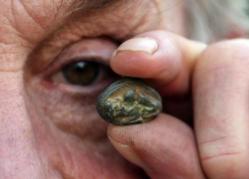 Pylle - Bob Dix found the rarity in the back garden of his former home and, without any further thought, tucked it away for safe-keeping. But he only realised the pendant could be special after a similar brothel token appeared in the press earlier this month. Mr Dix’s raunchy Roman jewellery shows a man and woman engaged in a sex act. He said: ‘I believe the piece I found is slightly different to the one in London - I think it was what the prostitutes would have worn round their necks and people would recognise what service they were willing to provide.’ The pendant was originally found in the village of Pylle, Somerset, which is close to the Roman road known as Fosse Way and a former ancient settlement.
Pylle - Bob Dix found the rarity in the back garden of his former home and, without any further thought, tucked it away for safe-keeping. But he only realised the pendant could be special after a similar brothel token appeared in the press earlier this month. Mr Dix’s raunchy Roman jewellery shows a man and woman engaged in a sex act. He said: ‘I believe the piece I found is slightly different to the one in London - I think it was what the prostitutes would have worn round their necks and people would recognise what service they were willing to provide.’ The pendant was originally found in the village of Pylle, Somerset, which is close to the Roman road known as Fosse Way and a former ancient settlement.
http://www.metro.co.uk/news/887932-amateur-archaeologist-unearths-roman-prostitutes-pendant#ixzz1k7ZRWnpe
ROYAUME UNI – 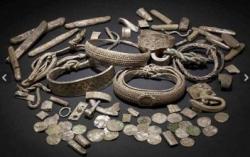 – Furness - The important Viking treasure find, unveiled at Barrow’s Dock Museum last year and currently being evaluated at the British Museum, will be the topic of one of the talks at the 39th Annual Archaeological Forum being held from 9.30am in the Faraday Lecture Theatre in Lancaster University. Dot Boughton, the Lancashire finds liaison officer for the government’s Portable Antiquities Scheme, will give an insight into the history and importance of the Furness find of 90 silver coins, ingots and jewellery items. They were believed to have been concealed around 950 at a time when Furness was still not officially part of England. She will also be describing the equally significant recent find of more than 200 silver items known as the Silverdale Hoard, plus other recent finds in Lancashire and Cumbria.
– Furness - The important Viking treasure find, unveiled at Barrow’s Dock Museum last year and currently being evaluated at the British Museum, will be the topic of one of the talks at the 39th Annual Archaeological Forum being held from 9.30am in the Faraday Lecture Theatre in Lancaster University. Dot Boughton, the Lancashire finds liaison officer for the government’s Portable Antiquities Scheme, will give an insight into the history and importance of the Furness find of 90 silver coins, ingots and jewellery items. They were believed to have been concealed around 950 at a time when Furness was still not officially part of England. She will also be describing the equally significant recent find of more than 200 silver items known as the Silverdale Hoard, plus other recent finds in Lancashire and Cumbria.
http://www.nwemail.co.uk/memories/spotlight-falls-on-year-of-treasure-1.916860?referrerPath=home
USA – 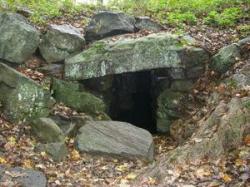 Upton - An odd landmark in the woods of Elm Street remains a mystery after archeological testing this winter yielded inconclusive results on when it was built, and what it was used for. Westford archaeologist David Gutbrod started studying the 15-foot structure known as Pearson Stone Chamber in September, and presented a report to the town’s Historical Commission this week. Gutbrod conducted archeological remote sensing technology, which uses ground penetrating radar that pushes electromagnetic pulses through the earth to get subsurface images under the structure. He also compared historic photographs dating back to 1938 to compare the site with satellite imagery. The data, he said, showed some “surface anomalies” where some underground disturbances may have occurred, like a rectangular feature that may indicate previous excavation or rock quarrying, he said. “Those (findings) could enlighten future research to previous uses, and could be very interesting to researchers and different people involved in site,” he said. Martin Dudek, a Hudson, N.Y., archaeologist, pulled samples from the soil around the cavern in September to figure out its age and origin, but that testing also did not yield an age or purpose.
Upton - An odd landmark in the woods of Elm Street remains a mystery after archeological testing this winter yielded inconclusive results on when it was built, and what it was used for. Westford archaeologist David Gutbrod started studying the 15-foot structure known as Pearson Stone Chamber in September, and presented a report to the town’s Historical Commission this week. Gutbrod conducted archeological remote sensing technology, which uses ground penetrating radar that pushes electromagnetic pulses through the earth to get subsurface images under the structure. He also compared historic photographs dating back to 1938 to compare the site with satellite imagery. The data, he said, showed some “surface anomalies” where some underground disturbances may have occurred, like a rectangular feature that may indicate previous excavation or rock quarrying, he said. “Those (findings) could enlighten future research to previous uses, and could be very interesting to researchers and different people involved in site,” he said. Martin Dudek, a Hudson, N.Y., archaeologist, pulled samples from the soil around the cavern in September to figure out its age and origin, but that testing also did not yield an age or purpose.
http://www.milforddailynews.com/news/x1192848596/Upton-chamber-remains-mystery-despite-testing?zc_p=1
ROYAUME UNI – 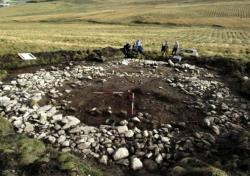 – Daer – Archaeologists working on pre-historic sites at Daer are discovering further sites within a forestry plantation – revealing new parts of Scotland’s story. For the first time Biggar Archaeological Group has found colouring substances, used by hunter-gatherers over 6000 years ago. “Haematite was rubbed on stones to give a bright maroon coloured powder which makes good paint,” explained group leader Tam Ward. “How it was used at Daer is not known but in Denmark, where graves are often found, the skeletons are covered in this stuff. “The overlap between the hunters and the first farmers has also been found and is causing some excitement.”
– Daer – Archaeologists working on pre-historic sites at Daer are discovering further sites within a forestry plantation – revealing new parts of Scotland’s story. For the first time Biggar Archaeological Group has found colouring substances, used by hunter-gatherers over 6000 years ago. “Haematite was rubbed on stones to give a bright maroon coloured powder which makes good paint,” explained group leader Tam Ward. “How it was used at Daer is not known but in Denmark, where graves are often found, the skeletons are covered in this stuff. “The overlap between the hunters and the first farmers has also been found and is causing some excitement.”
http://www.carlukegazette.co.uk/community/sites_at_daer_gives_new_clues_to_scotland_s_history_1_2065963
USA – 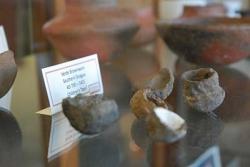 Verde Valley - The symposium, planned for Oct. 19-20, will focus on the Southern Sinagua, the ancient people who inhabited the Verde Valley from about 700 to 1425. Although there has been a good deal of research done, much of it remains obscure and little of it has been compiled. "There is a lot of archaeology here in the Verde valley and a lot of important archaeology," says VVAC director Todd Bostwick, "but as far as the professional community is concerned, it is one of those areas that is known, but little known.
Verde Valley - The symposium, planned for Oct. 19-20, will focus on the Southern Sinagua, the ancient people who inhabited the Verde Valley from about 700 to 1425. Although there has been a good deal of research done, much of it remains obscure and little of it has been compiled. "There is a lot of archaeology here in the Verde valley and a lot of important archaeology," says VVAC director Todd Bostwick, "but as far as the professional community is concerned, it is one of those areas that is known, but little known.
http://verdenews.com/main.asp?SectionID=1&SubSectionID=1&ArticleID=45815je
MARTINIQUE – 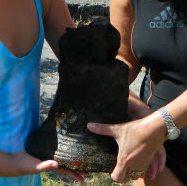 Saint Pierre - Sylvie Quéméré-Imbert a un institut de beauté à Saint-Pierre. Monitrice de plongée au centre Papa d'Lo, elle a l'habitude de sillonner sa baie. Dimanche, lors d'une baignade sur la plage du bourg, elle a découvert une ancienne cloche de bateau, datant de 1878, avec l'inscription «La Bonne Mère de Paimpol». Il est plausible qu'il s'agisse d'un bateau coulé lors de l'éruption volcanique de 1902. La cloche est désormais conservée dans un bac d'eau de mer pour lui éviter de s'oxyder à l'air, en attendant une expertise.
Saint Pierre - Sylvie Quéméré-Imbert a un institut de beauté à Saint-Pierre. Monitrice de plongée au centre Papa d'Lo, elle a l'habitude de sillonner sa baie. Dimanche, lors d'une baignade sur la plage du bourg, elle a découvert une ancienne cloche de bateau, datant de 1878, avec l'inscription «La Bonne Mère de Paimpol». Il est plausible qu'il s'agisse d'un bateau coulé lors de l'éruption volcanique de 1902. La cloche est désormais conservée dans un bac d'eau de mer pour lui éviter de s'oxyder à l'air, en attendant une expertise.
http://www.letelegramme.com/local/cotes-d-armor/lannion-paimpol/paimpol/paimpol/tresor-la-cloche-d-un-bateau-de-paimpol-en-martinique-20-01-2012-1571364.php
FRANCE – Nancy - Avec Francis Janot, professeur en odontologie, mais aussi égyptologue, le doyen Pierre Bravetti a mis en place, dans le cadre d’un master d’odontologie, la spécialité archéologie et criminalistique. Francis Janot a évoqué la recherche d’indices dans une dune de sable de la nécropole de Saqqâra en Egypte. Le matin, il avait résumé l’approche archéologique d’un squelette du IV e siècle après J.-C. et comment on pouvait en déduire sa mort suspecte, à partir de l’omoplate et du bras droits ayant glissé sous la jambe gauche et de la main gauche retrouvée sous la jambe droite. Le mort avait probablement les mains liées dans le dos. L’an dernier, une étudiante avait soutenu sa thèse en présentant la reconstruction plastique du visage d’une Egyptienne, à partir de son seul crâne. Une autre étude avait montré que l’usure anormale des dents d’une momie pouvait laisser penser qu’elle mâchait des herbes, peut-être dans un but divinatoire. Quant à la « Dame d’Antinoé », momie exhumée par Albert Gayet, lors d’une campagne de fouilles en 1904-1905 et déposée au château de Lunéville, elle a bénéficié d’un scanner et d’une étude approfondie, détaillée dans un ouvrage collectif, rédigé sous la direction de Francis Janot, aux Presses universitaires de Nancy.
http://www.estrepublicain.fr/meurthe-et-moselle/2012/01/22/les-os-et-les-dents-parlent